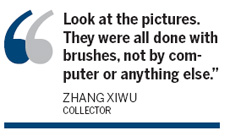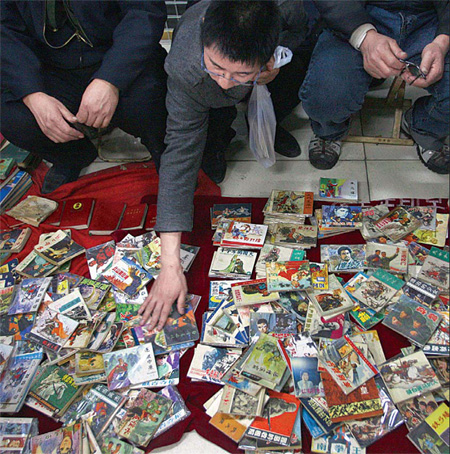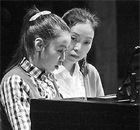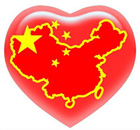Life
For collectors, tiny tomes are a handful
By Qin Zhongwei (China Daily)
Updated: 2010-04-12 08:22
 |
Large Medium Small |
|
Picture books on sale in Panjiayuan Antique Market. [Zou Hong / China Daily] |
Palm-sized picture books that were usually read by children several decades ago are now a big sensation in the city's antique markets.
During the Panjiayuan market's 8th annual fair for the palm-size picture books, called xiaorenshu, over the weekend, collectors flipped through - and over -the booklets.
The artistic value of the books, limited supply and booming market demand conspired to keep prices of these diminutive artworks surging.
Xiaorenshu was found in China in the early 1900s and are considered the predecessor of manga, Japanese comic books and graphic novels.
Despite their petite size, the books' content literally covers a vast swath of subject matter, particularly the ones published in the 1950s and 1960s, the heyday of the booklets.

The picture books include literature from home and abroad, including The Dream of Red Mansions or Journey to the West, and more contemporary stories reflecting modern wars and romance. Examples of world literature include the tragedies of Shakespeare.
At the time of their publication, the picture books were quite affordable, about 0.1 yuan each.
Ge Jihao, 49, of Xuzhou, Jiangsu province, has attended each antiques expo in Beijing to meet fellow hobbyists.
He noted the booming appreciation in prize booklets' value.
The 1970 version of Alphonse Daudet's La Dernire Classe can be found for about 60 yuan. Other titles are even more precious. For example, an entire set of well-preserved The Three Kingdoms was sold at auction for more than 200,000 yuan.
Gao told METRO he can earn about 10,000 yuan by selling from his collection during the three-day expo.
For many collectors, the books' value extends well beyond their monetary worth.
Zhang Xiwu, a professional collector in his 50s from Jilin province, said the booklets trigger memories. He recalls reading the picture books in his youth but has a newfound appreciation; when he re-reads the books as an adult, he recognizes that them as "masterpieces of art".
"Look at the pictures," Zhang said. "They were all done with brushes, not by computer or anything else. Various Chinese painting styles are depicted in these picture books. But one thing in common is that each picture took a lot of time and energy, not to mention what they painted are literature classics."
The palm-size booklets' resurgence began in 2000, when collectors rediscovered the art, according to Zhang. Fan groups sprouted in a few cities. Zhang and Ge, for their part, belong to such groups.
"I used to like playing mahjong after retirement just like most people living in my city," said Zhang's wife, surnamed Dong.
"But I quit it six or seven years ago since I started helping my husband sell the books and later on fell in love with collecting. It has some sort of magic," she said. Most of the titles were carefully sheathed in transparent plastic envelopes.
"We travel to different cities every year, and talk with local friends who have the same hobbies we do. It is a lot of fun," she said. "We not only make money, but we make friends, too."









